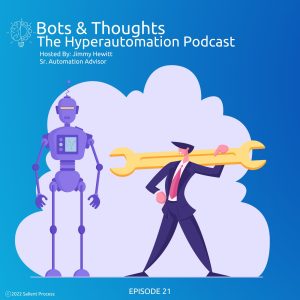
Join us as host Jimmy A. Hewitt chats with Greg Pollack, IBM’s Business Automation Sales Leader for the Americas, about his insight on the future of Digital Business Automation and the incredible value it brings over time.
Greg has over 10+ years in the Digital Automation space, leading sales across the Americas for IBM’s Business Automation software. His focus is helping customers realize the benefits of automation capabilities to help transform their business with Digital Business Automation.
Watch Episode 21 interview now!
Follow along with the episode now!
 This position oversees
This position oversees
North America
Canada
and Latin America sales of DBA
Greg works with customers in different industries and gets to listen to what they’re doing in their job, hear their challenges, etc
He interacts with product management team to understand and help give them the voice of the customer which is really important when you’re bringing products to market and helping customers achieve success with automation.
He makes this aspect the priority in his job to help not only the customers in this way but the business. IBM is solving complex problems and helping clients do that and that’s a huge part of his day to day.
Greg’s first role at IBM was selling Dev Ops Technology to the government
Every customer is going to have a different set of goals that they prioritize whether you’re working with a specific line of business or someone who’s at a high level in the organization but almost every automation revolution has shared very simple goals that are all very similar.
Get more some with the people you have or with less resources. Right now, we are seeing budgets tightening and a potential recession underway, so focusing on productivity is key.
As we have seen with RPA and a number of automation technologies, the ability to reduce mistakes / human error in a business is a critical goal in 2023
Every customer is different but those 3 common goals are the baseline for what we see clients are trying to achieve
Whether it’s a process or workflow, etc. A lot of the challenges our customers faced in the past that was evident is they have all of these lofty automation goals
For example, RPA is how many minutes did we save out of the day. A lot of the time the customer picks processes to automate because of an emotional reaction, but at the end of the day is it delivering ROI? Now, we have technology that allows us to not only identify the processes but we can do so in a data driven approach.
Operations leaders constantly talk about how many applications they have. Modern applicator estates have thousands of different applications; Saas Solutions, apps being built, etc.
These senior leaders have a hard time understanding the complexity of everything and now have visibility to how we can improve or reduce that estate and make things more frictionless
Companies are spending billions and not operating at full capacity which goes back to #1 identifying the right thing to automate. A lot of companies are investing in automation but ultimately, the budget is going toward solving other issues and when it comes to automation it isn’t the forefront of the conversation.
Organizations need to attract and retain their talent. Employees want to feel heard, empowered, and focus on meaningful work. They don’t want to do mundane tasks. We want companies to embrace automation for this reason. Having the right skills and employee experience does create a better customer experience.
Company with SG&A expenses, line item in their annual report is around a billion dollars. It’s an operational expense. It’s been growing 10% quarter after quarter and it’s a challenge. They’re stacking on 100 mill per yr in incremental operational expenses…so how can DBA help curbing these expenses? How can we streamline operations? How can we get more out of your people.
DBA has solutions in the Content management/ Data capture space. We see a lot of companies invest in getting rid of paper based processes, investing in more of a modern content services estate, getting away from the legacy tools
Episode 2, Season 1: The history of Digital Business Automation episode talks about the digital back office and now we are in 2023 and we still don’t have digital offices.
Southwest’s Senior VP came out and said they need to address the need for automation and how to handle crew reassignments and how it would of helped them prevent the disasters
Automation is pervasive. Customers face these challenges everyday. The focus is not just big enterprise, but to bring our P.O.V on automation to every business big or small because these challenges do exist.
Some small companies don’t have the budget for automation and that’s where the challenge is, how can we give them something of sundance and solve problems and not break their bank?
“Salients sweet spot is helping companies grow their automation practice with the expertise that you offer with the technology that IBM has.” – Greg Pollack
Our customer journey does start with process mapping, mining, business architecture… you have to x-ray before you operate.
There are a lot of areas to operate in a business- so prioritizing those opportunities, developing a business case for these opportunities, pitch them to your leadership, get it implemented, get the quick wins and immediate impacts wracked up and you start to really see the ball rolling does the path of virtuous self funding business automation.
It’s rewarding for us to help clients identify these opportunities with process discovery and solving those opportunities.
The benefits of Intelligent Automation have been growing as the technology matures. The simple explanation is that you now have the ability to process extremely high values of unstructured and structured data, leveraging RPA bots, and invest to drive out the manual mundane work. What this has done is:
Evolving the market and including more AI, Machine Learning technologies in 2023 to make the Intelligent Automation more viable in the mainstream. That’s going to augment how these strategic employees to be more efficient and drive out operational costs out of the business. Whatever your kpis are, using DBA will help you get there. We have a automation capability that will help to benefit you.
When IBM acquired their Process Mining company, Mike Lim (previous podcast guest) asked Greg to lead the acquisition in North America. Greg did some research on the tool and was blown away by the potential of some of the challenges it could help solve.
Digital Twins have mostly been used in manufacturing / engineering and they have realized the value of maintaining a digital representation of a process, or a service or a physical object that’s associated with a particular technology.
Now we have this technology where automation leaders can maintain a digital twin of their workflows / entire business processes not only across one line of business but throughout their entire enterprise
The potential of what that can deliver from an automaton perspective long term has incredible benefits. We can dramatically improve and accelerate the continuous improvement cycle for operational excellence.
” We are kind of at that inflection point with automation, where it could potentially be called “Biz Ops” where the concept of continuously delivering automations and then using this digital twin to say “okay if i made this change. or implemented a specific RPA bot or an improved workflow” whatever system we are trying to impact- we could see what the net benefit result in real time to see if the changes worked or not – and if it did work, what was the ROI and what is the next project I want to tackle. So having these digital twins has been a huge boom for customers.”
Forrester analysts says the implementation aspect for customers is in the experimental phase. But once customers do implement this technology, it is eye opening.
“You need change management within an organization. You’ve got to have people who own the data and involved in the process. You’ve got to have people who understand the business that you’re trying to impact whether its finance, customer centric or HR onboarding. You have to have all of the stakeholders at the table, and a lot of the time customers forget that the data is the most important person at the table.” – Greg Pollack
Empowering more business users to be involved in the process. In 2022, we saw a number of competitive RPA transitions whether it was:
We saw people moving from different vendors and trying new technologies because that space has evolved since 2018. IBM is a player in this space and doing their best to help customers.
These trends could be for beginning or advanced Digital Business Automation journeys
The difference between the two entry points:
Using Blueworks Live to map processes.
“Blueworks Live is fantastic, I think it’s probably industry leading, process mapping tool.” – Greg Pollack
IBM introduces process mining and some clients are just interested in process mapping from a human centric P.O.V and see how the processes work operationally. For some, process mining is too advanced vs understanding how something works.
Even if you aren’t using Process Mining, having a digital twin without taking action on anything you’ve learned has value at a baseline.
“I think there’s a huge need for this and even though Forrester is saying its [digital twins] experimental, I think folks should be be really diving into the pool headfirst and learning what it can do for their business because I would say about 90-95% of the customers who we have implemented this and worked with, have realized significant benefits and that’s just getting started. Now there’s a whole pipeline of opportunities they have discovered.”
There’s always a need for new skills especially with new technologies.
New AI is going to mark an acceleration for a shift of skills
The need for skills such as both technological or emotional- these skills are always evolving. Workers everywhere are going to have to deepen their existing skill sets and understanding how to work with the bots.
Stigma around bots taking over is not true. Companies need to rethink how their work is organized and what can be passed off to the bots and what high value work they can focus on. We will be interacting with increasingly smarter machines as these technologies continue to advance and mature.
“Human in the loop” is going to be a lot more meaningful and bring a lot more benefits to business.
It is used to improve corporate performance, customer experience, employee experience, etc. This is going to change the skills of human workers to evolve. There are going to be a range of higher value skills they need to learn vs the mundane, day-to-day operations. They are going to be needed to perform higher value work.
As technologies evolve, skills evolve and becoming more comfortable with having automation in your daily life.
The skills are going to have to be more aligned to a more data driven process analysis vs leading collaborative mapping sessions. The analysis evolves into something more continuous and data driven.
Skills are going to have to shift from being administrative to predictive in a way that they haven’t been in the past.
Spending less time collecting data and more time analyzing performance and finding ways to be more prosperous/efficient with the business they support.
YES! Bots & Thoughts is officially on all podcast streaming platforms. Check it out now!
We would love to hear from you. This podcast is for you, and if you have something that you want to hear, we would love to know. This form is also a place for you to ask questions or get in touch with our Salient Process team.
Submit a request for a podcast topic here❗


More on Digital Business Automation:
Digital Business Automation Home Page
What is Digital Business Automation?
Scaling Beyond RPA to Digital Business Automation
More on Salient Process:
Bots & Thoughts: The Digital Business Automation Podcast
Salient Process is a full-service digital business automation shop and proud IBM Automation business partner. To learn more about us at our website, request a free consultation with one of our expert automation advisors! We look forward to guiding you and your company along your own unique Digital Business Automation journey.